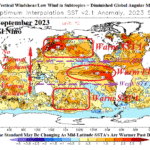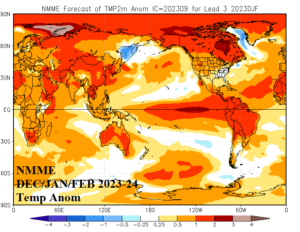Correlating Northeast Pacific SSTA and Europe Winter Temperature
09/17/2023, 11:02 am EDT
Why is Global Atmospheric Angular Momentum Negative Given El Nino Presence?
10/08/2023, 12:11 pm EDTExecutive summary: Recent research has revealed that Rossby Waves traveling from the lower latitudes poleward and from the troposphere to the stratosphere are less likely to occur when solar activity is stronger than normal. The influence of the upper and middle atmosphere by a stronger sun is increased solar wind which can prevent or lower the risk of upward travelling energy from the weather atmosphere (troposphere) in the form of a Rossby Wave. Consequently, sudden stratospheric warming events occurring during winter which can cause arctic outbreaks are less likely during an active sun.

Fig. 1: Schematic of where Rossby Waves typically form, their occasional trajectory into the polar stratosphere to cause sudden stratospheric warming, and the suppressing influence increased solar activity has on this process.
Discussion: What is a Rossby Wave? An extreme storm, collision of two very dynamic air masses, frequently initiated over fast-varying terrain such as the rise from the Indian Ocean to the Tibet Plateau (Fig. 1). Rossby Waves can also be generated by areas of enhanced convection in the tropics. If sufficiently intense, the heat generated by these intense storms is ejected into the upper atmosphere (above the troposphere) and poleward by the curvature of the earth and attendant Coriolis effect.
Rossby waves are the most effective process to transfer heat from the lower latitudes into the polar stratosphere. The event causes the stratosphere to warm due to expansion and therefore the troposphere beneath to contract cool. The weighty troposphere causes high pressure at the surface which leads to arctic air generation. As the polar vortex splits and travels south, arctic air follows the upper troughs into the mid-latitudes. This process can occur rapidly, sometimes referred to as a crashing Rossby Wave as the energetic pulse into the stratosphere collapses on the polar region. The rapid collapse of a Rossby Wave in the polar region stratosphere is known as a sudden stratospheric warming (SSW) episode.
Why are we talking about this subject? An El Nino winter is ahead. Alongside the warm waters in the eastern equatorial Pacific is a relatively new phenomenon, very warm mid-latitude ocean waters some of which are caused by marine heatwaves. The influence of anomalous warm ocean water (Fig. 2) leads to climate models forecasting an extremely warm climate and winter 2023-24 in the northern hemisphere (Fig. 3) is no exception. Consequently, other processes that can lead to arctic air outbreaks are reviewed and one of them is SSW episodes.


Fig. 2-3: NMME model projects SSTA for the global oceans during DEC/JAN/FEB 2023-24 and the attendant 2-meter temperature anomalies.
During an active sun (Fig. 4), the ionosphere is highly disturbed (“northern lights”). An increase in solar wind is initiated. If sufficiently intense, solar wind increase extends downward in the upper atmosphere to reach the stratosphere. The increased solar wind prevents upward traveling Rossby Waves from reaching the polar stratosphere lowering the risk of SSW events and the attendant arctic air generation which can release into the middle latitudes.

Fig. 4: Monthly sunspot number which indicates a choppy month-to-month rise toward solar maxima for solar cycle 25 expected to begin into 2024.
Conclusion: A mild El Nino winter is ahead for most of the northern hemisphere. Cold air bursts can still happen, although one way to trigger arctic outbreaks (sudden stratospheric warming) is less likely to occur due to the expectation of increased solar wind in the upper atmosphere as related to increased solar activity.
